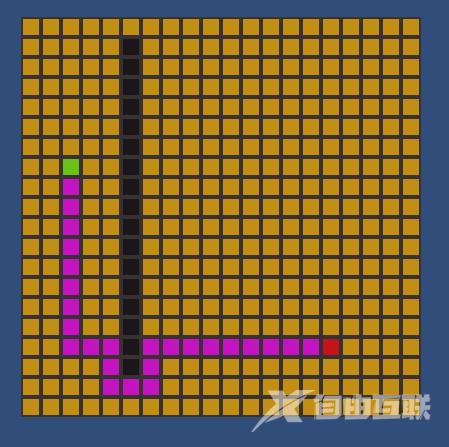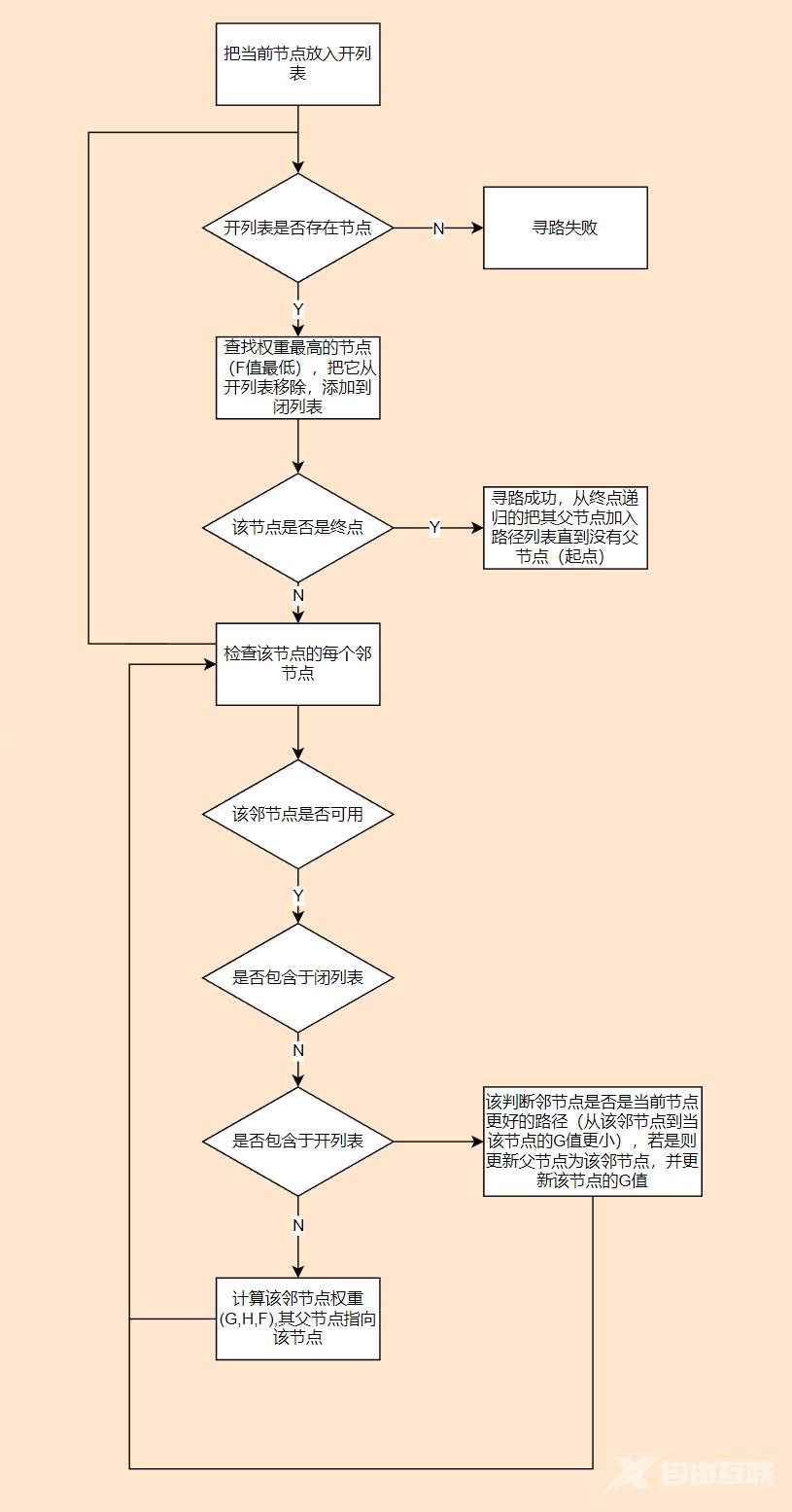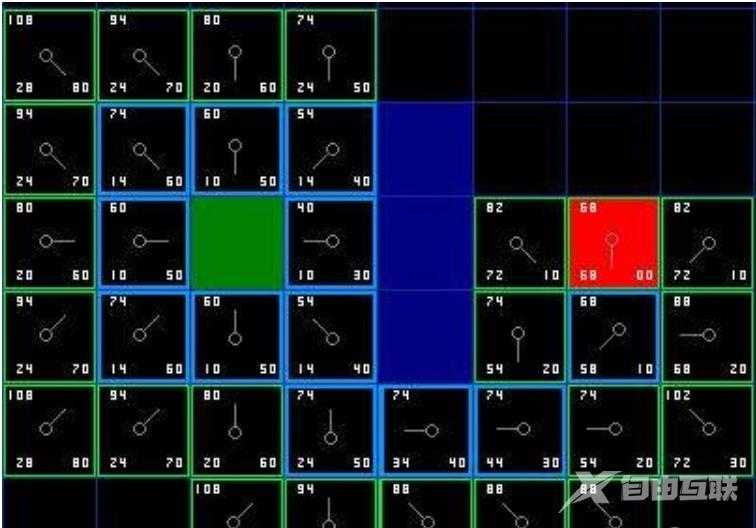目录 概述 思路 代码示例 位置定义 方向定义 估值函数 节点定义 算法上下文定义 寻路算法 初始化 获取路径 寻路 完整代码 概述 AStar算法是一种图形搜索算法,常用于寻路。他是以广
目录
- 概述
- 思路
- 代码示例
- 位置定义
- 方向定义
- 估值函数
- 节点定义
- 算法上下文定义
- 寻路算法
- 初始化
- 获取路径
- 寻路
- 完整代码
概述
AStar算法是一种图形搜索算法,常用于寻路。他是以广度优先搜索为基础,集Dijkstra算法和最佳优先(best fit)于一身的一种算法。
示例1:4向

示例2:8向

思路

递归的通过估值函数找到最佳路径,估值函数与距离相关,也有可能与通过代价系数相关(例如平地系数为1,坡地系数为2),有三个参数:
- G:起点点到当前点的代价
- H: 当前点到终点的代价
- F: F = G + H 与最佳路径权重负相关的参数
过程大概:

代码示例
位置定义
public struct Vec2
{
public int x;
public int y;
public Vec2(int x, int y)
{
this.x = x;
this.y = y;
}
public static Vec2 Zero
{
get
{
return new Vec2(0, 0);
}
}
public override bool Equals(object obj)
{
if (!(obj is Vec2))
return false;
var o = (Vec2)obj;
return x == o.x && y == o.y;
}
public override int GetHashCode()
{
return x.GetHashCode() + y.GetHashCode();
}
public static Vec2 operator +(Vec2 a, Vec2 b)
{
return new Vec2(a.x + b.x, a.y + b.y);
}
public static Vec2 operator *(Vec2 a, int n)
{
return new Vec2(a.x * n, a.y * n);
}
public static Vec2 operator *(int n, Vec2 a)
{
return new Vec2(a.x * n, a.y * n);
}
public static bool operator ==(Vec2 a, Vec2 b)
{
return a.x == b.x && a.y == b.y;
}
public static bool operator !=(Vec2 a, Vec2 b)
{
return !(a.x == b.x && a.y == b.y);
}
}
方向定义
public enum EDir
{
Up = 0,
Down = 1,
Left = 2,
Right = 3,
UpLeft = 4,
UpRight = 5,
DownLeft = 6,
DownRight = 7,
}
public abstract class CheckDirPol
{
abstract public Dictionary<EDir, Vec2> GetDir();
}
public class CheckDir4Pol : CheckDirPol
{
private Dictionary<EDir, Vec2> dirDict = new Dictionary<EDir, Vec2>
{
{EDir.Up, new Vec2(0, 1) },
{EDir.Down, new Vec2(0, -1) },
{EDir.Left, new Vec2(-1, 0) },
{EDir.Right, new Vec2(1, 0) },
};
override public Dictionary<EDir, Vec2> GetDir()
{
return dirDict;
}
}
public class CheckDir8Pol : CheckDirPol
{
private Dictionary<EDir, Vec2> dirDict = new Dictionary<EDir, Vec2>
{
{EDir.Up, new Vec2(0, 1) },
{EDir.Down, new Vec2(0, -1) },
{EDir.Left, new Vec2(-1, 0) },
{EDir.Right, new Vec2(1, 0) },
{EDir.UpLeft, new Vec2(-1, 1) },
{EDir.UpRight, new Vec2(1, 1) },
{EDir.DownLeft, new Vec2(-1, -1) },
{EDir.DownRight, new Vec2(1, -1) },
};
override public Dictionary<EDir, Vec2> GetDir()
{
return dirDict;
}
}
运用策略模式的技巧,以实现4向,8向搜索切换
估值函数
public abstract class EvaPol
{
abstract public float Calc(Vec2 a, Vec2 b);
}
public class MANEvaPol : EvaPol
{
override public float Calc(Vec2 a, Vec2 b)
{
return Mathf.Abs(a.x - b.x) + Mathf.Abs(a.y - b.y);
}
}
直接使用曼哈顿距离作为代价
节点定义
public class Node
{
public int id;
public Vec2 pos;
public float g;
public float h;
public float f;
public Vec2 prePos;
public bool hasPrePos;
public Node(Vec2 pos)
{
this.pos = pos;
}
public void SetPrePos(Vec2 pos)
{
prePos = pos;
hasPrePos = true;
}
}
算法上下文定义
Context context;
EvaPol disPol;
CheckDirPol checkDirPol;
public struct Context
{
public Vec2 end;
public Vec2 start;
public Node[,] nodes;
public List<Node> open;
public List<Node> close;
public int[,] map;
public List<Vec2> result;
public Vec2 size;
}
寻路算法
初始化
public void Init(Vec2 start, Vec2 end, int[,] map)
{
var x = map.GetLength(0);
var y = map.GetLength(1);
context = new Context()
{
start = start,
end = end,
open = new List<Node>(),
close = new List<Node>(),
map = map,
result = new List<Vec2>(),
size = new Vec2(x, y),
};
context.nodes = new Node[x, y];
for (int i = 0; i < x; i++)
for (int j = 0; j < x; j++)
context.nodes[i, j] = new Node(new Vec2(i, j));
disPol = new MANEvaPol();
//checkDirPol = new CheckDir4Pol();
checkDirPol = new CheckDir8Pol();
}
获取路径
public List<Vec2> GetResult()
{
return context.result;
}
寻路
寻路入口
public void FindPath()
{
var s = context.start;
var sn = context.nodes[s.x, s.y];
sn.g = 0;
sn.h = disPol.Calc(s, context.end);
sn.f = sn.g + sn.h;
context.open.Add(sn);
FindArrangement(sn);
}
递归函数
void FindArrangement(Node node)
{
context.close.Add(node);
context.open.Remove(node);
if (node.pos == context.end)
{
SetResult(node);
return;
}
CheckRound(node);
if (context.open.Count == 0)
return;
Node next = context.open[0];
for (int i = 1; i < context.open.Count; i++)
if (context.open[i].f < next.f)
next = context.open[i];
FindArrangement(next);
}
检查周围节点
void CheckRound(Node node)
{
var dirDict = checkDirPol.GetDir();
foreach (var pair in dirDict)
{
var dir = node.pos + pair.Value;
if (IsBlock(dir))
continue;
var dn = context.nodes[dir.x, dir.y];
if (context.close.Contains(dn))
continue;
if (context.open.Contains(dn))
TryOverridePath(node, dn);
else
{
dn.g = disPol.Calc(dn.pos, context.start);
dn.h = disPol.Calc(dn.pos, context.end);
dn.f = dn.g + dn.h;
dn.SetPrePos(node.pos);
context.open.Add(dn);
}
}
}
// 若是从邻节点到该节点路径更优,则替换更新
void TryOverridePath(Node a, Node b)
{
var g = a.g + disPol.Calc(a.pos, b.pos);
if (g < b.g)
{
b.g = g;
b.SetPrePos(a.pos);
}
}
bool IsBlock(Vec2 pos)
{
return !InMap(pos) || context.map[pos.x, pos.y] == 1;
}
bool InMap(Vec2 pos)
{
var x = pos.x;
var y = pos.y;
var size = context.size;
return x >= 0 && x < size.x && y >= 0 && y < size.y;
}
生成路径
void SetResult(Node node)
{
Queue<Node> q = new Queue<Node>();
while(node.hasPrePos)
{
q.Enqueue(node);
node = context.nodes[node.prePos.x, node.prePos.y];
}
while(q.Count > 0)
{
context.result.Add(q.Dequeue().pos);
}
}
完整代码
using System.Collections;
using System.Collections.Generic;
using UnityEngine;
public struct Vec2
{
public int x;
public int y;
public Vec2(int x, int y)
{
this.x = x;
this.y = y;
}
public static Vec2 Zero
{
get
{
return new Vec2(0, 0);
}
}
public override bool Equals(object obj)
{
if (!(obj is Vec2))
return false;
var o = (Vec2)obj;
return x == o.x && y == o.y;
}
public override int GetHashCode()
{
return x.GetHashCode() + y.GetHashCode();
}
public static Vec2 operator +(Vec2 a, Vec2 b)
{
return new Vec2(a.x + b.x, a.y + b.y);
}
public static Vec2 operator *(Vec2 a, int n)
{
return new Vec2(a.x * n, a.y * n);
}
public static Vec2 operator *(int n, Vec2 a)
{
return new Vec2(a.x * n, a.y * n);
}
public static bool operator ==(Vec2 a, Vec2 b)
{
return a.x == b.x && a.y == b.y;
}
public static bool operator !=(Vec2 a, Vec2 b)
{
return !(a.x == b.x && a.y == b.y);
}
}
public enum EDir
{
Up = 0,
Down = 1,
Left = 2,
Right = 3,
UpLeft = 4,
UpRight = 5,
DownLeft = 6,
DownRight = 7,
}
public class AstarFindPath
{
public class Node
{
public int id;
public Vec2 pos;
public float g;
public float h;
public float f;
public Vec2 prePos;
public bool hasPrePos;
public Node(Vec2 pos)
{
this.pos = pos;
}
public void SetPrePos(Vec2 pos)
{
prePos = pos;
hasPrePos = true;
}
}
public abstract class EvaPol
{
abstract public float Calc(Vec2 a, Vec2 b);
}
public class MANEvaPol : EvaPol
{
override public float Calc(Vec2 a, Vec2 b)
{
return Mathf.Abs(a.x - b.x) + Mathf.Abs(a.y - b.y);
}
}
public abstract class CheckDirPol
{
abstract public Dictionary<EDir, Vec2> GetDir();
}
public class CheckDir4Pol : CheckDirPol
{
private Dictionary<EDir, Vec2> dirDict = new Dictionary<EDir, Vec2>
{
{EDir.Up, new Vec2(0, 1) },
{EDir.Down, new Vec2(0, -1) },
{EDir.Left, new Vec2(-1, 0) },
{EDir.Right, new Vec2(1, 0) },
};
override public Dictionary<EDir, Vec2> GetDir()
{
return dirDict;
}
}
public class CheckDir8Pol : CheckDirPol
{
private Dictionary<EDir, Vec2> dirDict = new Dictionary<EDir, Vec2>
{
{EDir.Up, new Vec2(0, 1) },
{EDir.Down, new Vec2(0, -1) },
{EDir.Left, new Vec2(-1, 0) },
{EDir.Right, new Vec2(1, 0) },
{EDir.UpLeft, new Vec2(-1, 1) },
{EDir.UpRight, new Vec2(1, 1) },
{EDir.DownLeft, new Vec2(-1, -1) },
{EDir.DownRight, new Vec2(1, -1) },
};
override public Dictionary<EDir, Vec2> GetDir()
{
return dirDict;
}
}
public struct Context
{
public Vec2 end;
public Vec2 start;
public Node[,] nodes;
public List<Node> open;
public List<Node> close;
public int[,] map;
public List<Vec2> result;
public Vec2 size;
}
Context context;
EvaPol disPol;
CheckDirPol checkDirPol;
public void Init(Vec2 start, Vec2 end, int[,] map)
{
var x = map.GetLength(0);
var y = map.GetLength(1);
context = new Context()
{
start = start,
end = end,
open = new List<Node>(),
close = new List<Node>(),
map = map,
result = new List<Vec2>(),
size = new Vec2(x, y),
};
context.nodes = new Node[x, y];
for (int i = 0; i < x; i++)
for (int j = 0; j < x; j++)
context.nodes[i, j] = new Node(new Vec2(i, j));
disPol = new MANEvaPol();
//checkDirPol = new CheckDir4Pol();
checkDirPol = new CheckDir8Pol();
}
public void FindPath()
{
var s = context.start;
var sn = context.nodes[s.x, s.y];
sn.g = 0;
sn.h = disPol.Calc(s, context.end);
sn.f = sn.g + sn.h;
context.open.Add(sn);
FindArrangement(sn);
}
public List<Vec2> GetResult()
{
return context.result;
}
void FindArrangement(Node node)
{
context.close.Add(node);
context.open.Remove(node);
if (node.pos == context.end)
{
SetResult(node);
return;
}
CheckRound(node);
if (context.open.Count == 0)
return;
Node next = context.open[0];
for (int i = 1; i < context.open.Count; i++)
if (context.open[i].f < next.f)
next = context.open[i];
FindArrangement(next);
}
void SetResult(Node node)
{
Queue<Node> q = new Queue<Node>();
while(node.hasPrePos)
{
q.Enqueue(node);
node = context.nodes[node.prePos.x, node.prePos.y];
}
while(q.Count > 0)
{
context.result.Add(q.Dequeue().pos);
}
}
void CheckRound(Node node)
{
var dirDict = checkDirPol.GetDir();
foreach (var pair in dirDict)
{
var dir = node.pos + pair.Value;
if (IsBlock(dir))
continue;
var dn = context.nodes[dir.x, dir.y];
if (context.close.Contains(dn))
continue;
if (context.open.Contains(dn))
TryOverridePath(node, dn);
else
{
dn.g = disPol.Calc(dn.pos, context.start);
dn.h = disPol.Calc(dn.pos, context.end);
dn.f = dn.g + dn.h;
dn.SetPrePos(node.pos);
context.open.Add(dn);
}
}
}
void TryOverridePath(Node a, Node b)
{
var g = a.g + disPol.Calc(a.pos, b.pos);
if (g < b.g)
{
b.g = g;
b.SetPrePos(a.pos);
}
}
bool IsBlock(Vec2 pos)
{
return !InMap(pos) || context.map[pos.x, pos.y] == 1;
}
bool InMap(Vec2 pos)
{
var x = pos.x;
var y = pos.y;
var size = context.size;
return x >= 0 && x < size.x && y >= 0 && y < size.y;
}
}
到此这篇关于C# AStar寻路算法详解的文章就介绍到这了,更多相关C# AStar寻路算法内容请搜索自由互联以前的文章或继续浏览下面的相关文章希望大家以后多多支持自由互联!
